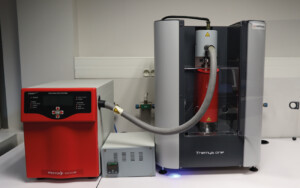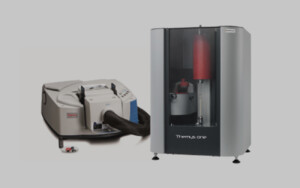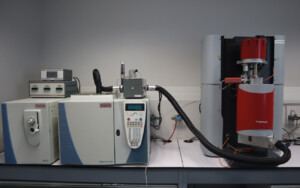An overview of Evolved Gas Analysis techniques
The coupling between thermogravimetric analysis and gas analysis methods such as MS (mass spectrometry), FTIR (infrared spectrometry) or GC-MS (gas chromatography-mass spectrometry) allows further analysis of the composition of a material or its thermal decomposition process.

Evolved Gas Analysis – Introduction to Evolved Gas Analysis
If thermogravimetric analysis allows to detect and quantify the mass losses linked to the thermal decomposition of a material sample, it cannot formally identify the gases released during the phenomenon. It is necessary to carry out complementary measurements, or to couple a gas analyzer at the exit of the furnace of the thermogravimetric analyzer.
For this purpose, a coupling piece is adapted at the furnace outlet, as well as a transfer line. This equipment allows to take all or part of the gas leaving the oven and to bring it to the inlet of the gas analyzer. The whole system is heated in order to avoid condensation of the gases whose boiling temperature is higher than the ambient temperature. The maximum temperatures of these transfer lines are typically between 200 and 300°C.
Some equipment allows the combination of several gas analyzers with a thermogravimetric analyzer.
The applications of analysis of the emitted gases are :
- The search for particular molecules, released by a material during its pyrolysis or its combustion:
o To promote their production: aromatic molecules, chemically recoverable molecules.
o To limit their emission: toxic gas or vapor.
- Fine analysis of the composition of materials, for example in the context of reverse engineering
TG-MS coupling
In a TGA system coupled to a MS, the gases released by the sample are rapidly sucked to the ionization source of the mass spectrometer thanks to the pressure difference between the TGA oven (about 1 bar) and the MS (about 10-7 mbar).
After being ionized, the molecules and fragments are then separated according to their mass/charge ratio (m/z) using a quadrupole and are detected by an electron multiplier detector or a Faraday detector.
The intensity of one or more molecules or fragments can be followed and superimposed on the mass variation signal to associate the evolved molecules to the different mass losses.
This type of coupling has the best detection limit and is more applicable to the detection of low molecular weight molecules.

TG-FTIR coupling
In the case of the coupling of a thermogravimetric analyzer with an FTIR, the totality of the gases leaving the TGA furnace is led to the FTIR. In this measuring cell, the chemical groups of the gaseous molecules are identified according to their specific absorption of the infrared light wavelengths.
The intensities of the peaks corresponding to a chosen chemical function can be superimposed on the mass variation of the sample.
The experimental spectra can be compared with those of reference material libraries for the identification of the released substances.
This method is less sensitive but allows to detect families of molecules, even complex ones.

TG-GC-MS coupling
In TG-GC-MS coupling, the evolved species are first separated by the chromatograph before being identified by the mass spectrometer.
This method is the most efficient to identify the released molecules when they are very diverse. It is however more complex to implement and imposes certain experimental conditions on the thermogravimetric analyzer.
